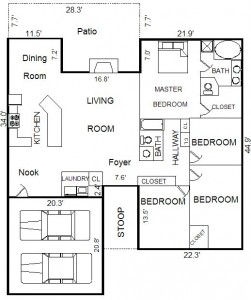I’m writing this post because of an article I saw recently online. The article was about what homeowners could do to improve their home appraisal. It provided helpful tips that I agreed with, but I did not agree with the quote from an appraiser that was included. He stated that “The reality is that the appraiser is only there for 30 minutes at most”, as to infer that most appraisers do not spend adequate time to do the job right. While I am sure that there are some smaller homes that may not require much more than “30 minutes at most”, I find it usually takes longer than this short time if you are doing your job correctly. There may be some appraisers who cut corners to save time but I think that most of them want to do a good job.
It provided helpful tips that I agreed with, but I did not agree with the quote from an appraiser that was included. He stated that “The reality is that the appraiser is only there for 30 minutes at most”, as to infer that most appraisers do not spend adequate time to do the job right. While I am sure that there are some smaller homes that may not require much more than “30 minutes at most”, I find it usually takes longer than this short time if you are doing your job correctly. There may be some appraisers who cut corners to save time but I think that most of them want to do a good job.
Even though I have been in this profession close to 23 years, and have worked out a pretty good routine when inspecting homes, it still takes time to do the job right. I thought it would be helpful to the general public, including homeowners and real estate agents, to know exactly what an appraiser typically does during the inspection of the home for the appraisal. There is no official order in which appraisers must look at a property, however after it is all said and done the information gathered should be the similar.
I personally like to start with measuring the exterior of the home after meeting the homeowner. By measuring the home first I can more easily identify the room layout when I am doing the interior inspection. Single story homes with no basements are usually the easiest to measure, because when you are finished measuring the main level you don’t have to worry about a second floor  or basement. Two story homes can be measured from the outside if the second floor is identical to the first, however if they are not then you must measure from the inside. This is also true of the basement, which usually has a similar footprint as the 1st level. However, if there is finished area this must also be measure as well. Measuring the home is critical in the appraisal process because the main unit of comparison is price per square foot. If you improperly measure the home it can carry through the whole appraisal process and end up giving you an inaccurate value estimate. In addition to the main residence, any other improvements on the property must also be measured, such as detached garages, workshops, barns, pools, and boathouses. We measure all of these improvements to use in developing the cost approach to value. The lot or site the house is on is also inspected to determine topography, proximity to adjacent properties, and size.
or basement. Two story homes can be measured from the outside if the second floor is identical to the first, however if they are not then you must measure from the inside. This is also true of the basement, which usually has a similar footprint as the 1st level. However, if there is finished area this must also be measure as well. Measuring the home is critical in the appraisal process because the main unit of comparison is price per square foot. If you improperly measure the home it can carry through the whole appraisal process and end up giving you an inaccurate value estimate. In addition to the main residence, any other improvements on the property must also be measured, such as detached garages, workshops, barns, pools, and boathouses. We measure all of these improvements to use in developing the cost approach to value. The lot or site the house is on is also inspected to determine topography, proximity to adjacent properties, and size.
After the exterior is inspected, and the pictures are taken, the appraiser is ready to look at the interior. Most lenders these days require appraisers to take pictures of every room in the house as well as any features that adds significant value to the property. If there is any damage to the home or repairs to be made the appraiser must make note of this as well. As the appraiser goes from room to room notes are taken on the quality of construction, materials of construction, and condition of the home. Items such as crown molding, chair rail, hardwood floors, and windows can help the appraiser determine the quality level of the home. In addition, any special features of the home are noted, such as fireplaces, security systems, built-in appliances, and home theater systems to name a few.
Homeowners can point out features that may not be readily visible to help the appraiser be as accurate as possible. The layout or floor plan of the home is also analyzed. Bad floor plans can have a negative effect on the value of the home if most buyers do not like it. The appraiser is not a home inspector, however they do look at the electrical, plumbing, and HVAC systems to see if there are any outwardly visible signs of damage. Later in the appraisal process this information is used to compare the subject against recent sales in order to arrive at the best comparables possible.
analyzed. Bad floor plans can have a negative effect on the value of the home if most buyers do not like it. The appraiser is not a home inspector, however they do look at the electrical, plumbing, and HVAC systems to see if there are any outwardly visible signs of damage. Later in the appraisal process this information is used to compare the subject against recent sales in order to arrive at the best comparables possible.
As you can see, the appraiser observes a lot during the property inspection and it can be time consuming, especially on larger custom built homes. This is by no means a complete description of everything an appraiser looks for, however it does give you an idea of the process they go through. I hope this provides you with an adequate description so that you can determine if the appraiser has given your home the full attention it deserves. If you have any further questions please feel free to leave me a message below.
If you have any real estate appraisal related questions you can call me at 205.243.9304, email me, or connect with me on Facebook., Twitter, or Youtube.
It’s a good thing you’re thorough. If the inspection is too quick, something is going to be missed.
I don’t claim my appraisal inspections are perfect but I do recognize that it takes time to do it right. If you fly through the inspection it may give the homeowner an inaccurate picture of your thoroughness, even if you did do what you were suppose to.
Nice post, Tom. The field inspection process certainly takes time to do it right.
You’re right Wendell, it can. The homeowner can aid in the process by having a list of recent updates and renovations as well as a list of features for the home. Of course these have to be verified by visual inspection by the appraiser.